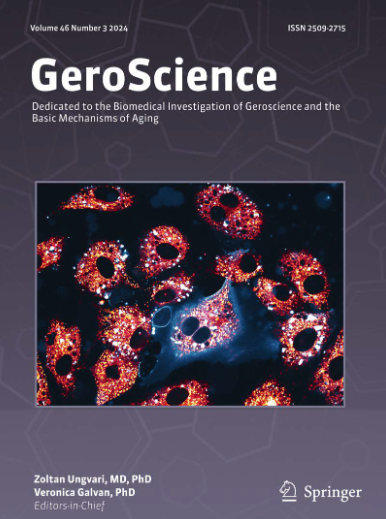Expression of progerin enhances disease-related endpoints in a tau seeding reporter cell system.
IF 5.3
2区 医学
Q1 GERIATRICS & GERONTOLOGY
引用次数: 0
Abstract
Sporadic Alzheimer's disease and some forms of frontotemporal lobar degeneration (FTLD-tau) are neurological disorders of later life where cognitive deficits follow from the progressive accumulation of microtubule-associated tau protein. Disease-related tau accumulation is marked by altered subcellular distribution and rearrangement of this natively unstructured protein into alternative conformational forms, including highly organized fibrillar assemblies. With a partial analogy to effects seen in prion diseases, pathological tau conformers have a templating activity called seeding that may be measured in cellular and cell-free systems. Moreover, cellular systems and disease models can recapitulate "strain effects" wherein the same tau amino acid sequence can adopt markedly different conformations. Here we analyzed FTLD-tau conformers in cellular reporter systems expressing a pro-aging mutant form of the lamin A protein termed "progerin." Measured versus the baseline performance of a reporter system based on HEK293 cells, the addition of tau burden or progerin expression produced only mild changes in proteomic analyses or morphology, whereas application of both stressors produced a notable shift in ER stress and homeostasis, including increased levels of DNAJC10 and DNAJA2. The phenotypic effects scored here appear unrelated to the generation of new tau strains or to the type of strain input, insofar as progerin-expressing cells were more responsive to tau seeding by diverse brain samples containing different populations of tau conformers. Thus, premature aging and disease-associated tau conformers can exhibit an additive relationship in a model system.在tau种子报告细胞系统中,progerin的表达增强了疾病相关终点。
散发性阿尔茨海默病和某些形式的额颞叶变性(FTLD-tau)是晚年的神经系统疾病,其中认知缺陷是由微管相关tau蛋白的进行性积累引起的。疾病相关的tau积累的标志是亚细胞分布的改变,以及这种天然非结构蛋白重新排列成其他构象形式,包括高度组织化的纤维组装。与朊病毒疾病的部分相似,病理性tau构象具有一种称为播种的模板活性,可以在细胞和无细胞系统中测量。此外,细胞系统和疾病模型可以概括“菌株效应”,其中相同的tau氨基酸序列可以采用明显不同的构象。在这里,我们分析了细胞报告系统中的FTLD-tau构象,表达一种促衰老突变形式的层合蛋白a蛋白,称为“progerin”。与基于HEK293细胞的报告系统的基线性能相比,tau负荷或progerin表达的增加只会在蛋白质组学分析或形态学上产生轻微的变化,而两种应激源的应用会产生内质网应激和稳态的显著变化,包括DNAJC10和DNAJA2水平的增加。这里得分的表型效应似乎与新tau菌株的产生或菌株输入的类型无关,因为表达progerin的细胞对含有不同tau构象群的不同脑样本的tau种子更敏感。因此,早衰和疾病相关的tau构象可以在模型系统中表现出一种加性关系。
本文章由计算机程序翻译,如有差异,请以英文原文为准。
求助全文
约1分钟内获得全文
求助全文
来源期刊

GeroScience
Medicine-Complementary and Alternative Medicine
CiteScore
10.50
自引率
5.40%
发文量
182
期刊介绍:
GeroScience is a bi-monthly, international, peer-reviewed journal that publishes articles related to research in the biology of aging and research on biomedical applications that impact aging. The scope of articles to be considered include evolutionary biology, biophysics, genetics, genomics, proteomics, molecular biology, cell biology, biochemistry, endocrinology, immunology, physiology, pharmacology, neuroscience, and psychology.
 求助内容:
求助内容: 应助结果提醒方式:
应助结果提醒方式:


